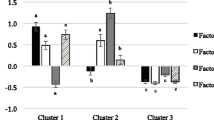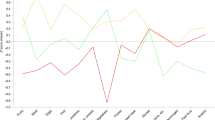Abstract
Objective:
To calculate intra-cluster and intra-household design effects and intra-class correlation coefficients for dietary nutrients obtained from a 24 h record-assisted recall.
Design:
Children were recruited using clustered probability sampling. Randomly selected starting-point addresses were obtained with probability proportional to mesh block size.
Setting:
Children aged 1–14 years in New Zealand.
Subjects:
There were 125 children in 50 clusters, giving an average of 2.498 children per cluster. In 15 homes, there were two children for the calculation of intra-household statistics.
Results:
Intra-cluster design effects ranged from 1.0 for cholesterol, β-carotene, vitamin A, vitamin D, vitamin E, selenium, fructose and both carbohydrate and protein expressed as their contribution to total energy intakes to 1.552 for saturated fat, with a median design effect of 1.148. Their corresponding intra-cluster correlations ranged from 0 to 0.37, respectively. Intra-household design effects ranged from 1.0 for height to 1.839 for vitamin B6, corresponding to intra-household correlations of 0 and 0.839. The median intra-household design effect was 1.550. Using a sampling design of two to three households per cluster for estimating dietary nutrient intakes would need, on average, a 15% increase in sample size compared with simple random sampling with a maximum increase of 55% to cover all nutrients.
Conclusions:
These data enable sample sizes for dietary nutrients to be estimated for both cluster and non-cluster sampling for children aged 1–14 years. The larger design effects found within households suggest that little extra information may be obtained by sampling more than one child per household.
Sponsorship:
The New Zealand Ministry of Health contracted this study.

Similar content being viewed by others
References
Armitage P, Berry G (1994). Statistical methods in medical research, 3rd ed. Blackwell Scientific Publications: Oxford.
Campbell MK, Grimshaw JM (1998). Cluster randomised trials: time for improvement. The implications of adopting a cluster design are still largely being ignored. BMJ 317, 1171–1172.
Connelly LB (2003). Balancing the number and size of sites: an economic approach to the optimal design of cluster samples. Control Clin Trials 24, 544–559.
Donner A, Brown KS, Brasher P (1990). A methodological review of non-therapeutic intervention trials employing cluster randomisation, 1979–1989. Int J Epidemiol 19, 795–800.
Donner A, Klahr N (2000). Design and analysis of cluster randomization trials in health research. Arnold: London.
Food Files (2004). Data Files of the New Zealand Food Composition Database. Palmerston North, New Zealand: New Zealand Institute of Crop & Food Research.
Gulliford MC, Ukoumunne OC, Chinn S (1999). Components of variance and intraclass correlations for the design of community-based surveys and intervention studies: data from the Health Survey for England 1994. Am J Epidemiol 149, 876–883.
Hampel FR (1974). The influence curve and its role in robust estimation. J Am Stat Assoc 69, 383–393.
Harville DA (1977). Maximum likelihood approaches to variance component estimations and to related problems. J Am Stat Assoc 72, 320–338.
Kerry SM, Bland JM (1998). The intracluster correlation coefficient in cluster randomisation. BMJ 316, 1455–1460.
Koepsell TD, Wagner EH, Cheadle AC, Patrick DL, Martin DC, Diehr PH et al. (1992). Selected methodological issues in evaluating community-based health promotion and disease prevention programs. Annu Rev Public Health 13, 31–57.
Metcalf PA, Scragg RK, Sharpe S, Fitzgerald ED, Schaff D, Watts C (2003). Short-term repeatability of a food frequency questionnaire in New Zealand children aged 1–14 years. Eur J Clin Nutr 57, 1498–1503.
Reading R, Harvey I, Mclean M (2000). Cluster randomised trials in maternal and child health: implications for power and sample size. Arch Dis Child 82, 79–83.
Rice N, Leyland A (1996). Multilevel models: applications to health data. J Health Services Res Policy 1, 154–164.
SAS Institute Inc (2004). SAS/STAT User's Guide Version 91. SAS Institute Inc.: Cary, NC.
Acknowledgements
Other collaborators on the Children's Nutrition Pilot Survey were Professor Boyd Swinburn, Dr Cameron Grant and Dr David Schaaf from the University of Auckland, Professor Mason Durie and Eljon Fitzgerald (Massey University, Palmerston North), Dr Elaine Rush (Auckland University of Technology) and Dr Clare Wall, Kate Sladden and Patsy Watson (Massey University, Albany). Dr Patricia Metcalf was supported by the Health Research Council of New Zealand.
Author information
Authors and Affiliations
Corresponding author
Additional information
Guarantor: PA Metcalf.
Contributors: RKRS, AWS and PAM contributed to the design of this study. PAM, AJS and AWS contributed to the statistical analysis and interpretation of the data. All authors contributed to the conduct of the study, data collection and writing of this manuscript.
Rights and permissions
About this article
Cite this article
Metcalf, P., Scragg, R., Stewart, A. et al. Design effects associated with dietary nutrient intakes from a clustered design of 1 to 14-year-old children. Eur J Clin Nutr 61, 1064–1071 (2007). https://doi.org/10.1038/sj.ejcn.1602618
Received:
Revised:
Accepted:
Published:
Issue Date:
DOI: https://doi.org/10.1038/sj.ejcn.1602618
- Springer Nature Limited
Keywords
This article is cited by
-
The role and requirements of digestible dietary carbohydrates in infants and toddlers
European Journal of Clinical Nutrition (2012)
-
The NOURISH randomised control trial: Positive feeding practices and food preferences in early childhood - a primary prevention program for childhood obesity
BMC Public Health (2009)
-
Assessing children's diet quality in Crete based on Healthy Eating Index: The Children Study
European Journal of Clinical Nutrition (2009)




